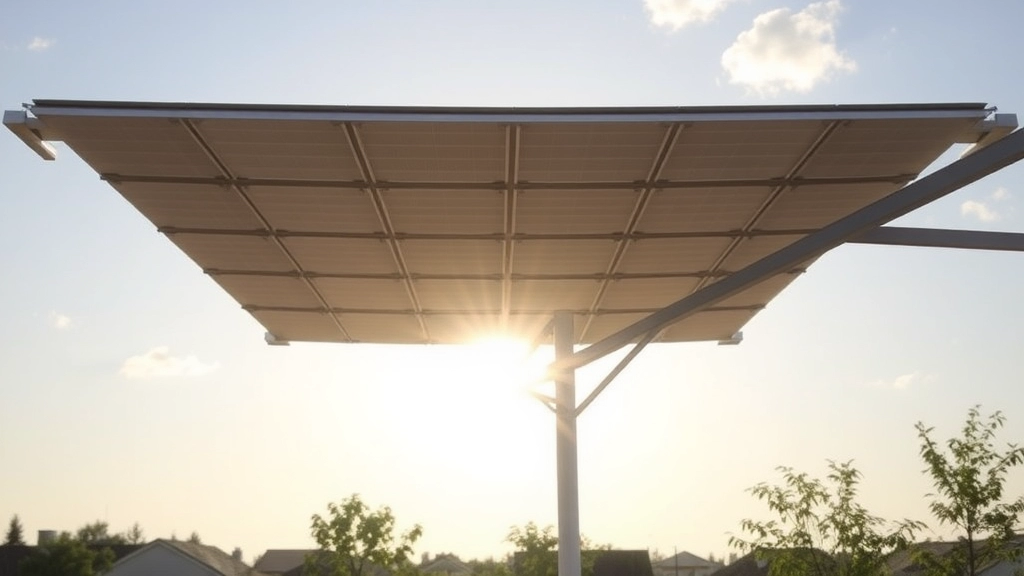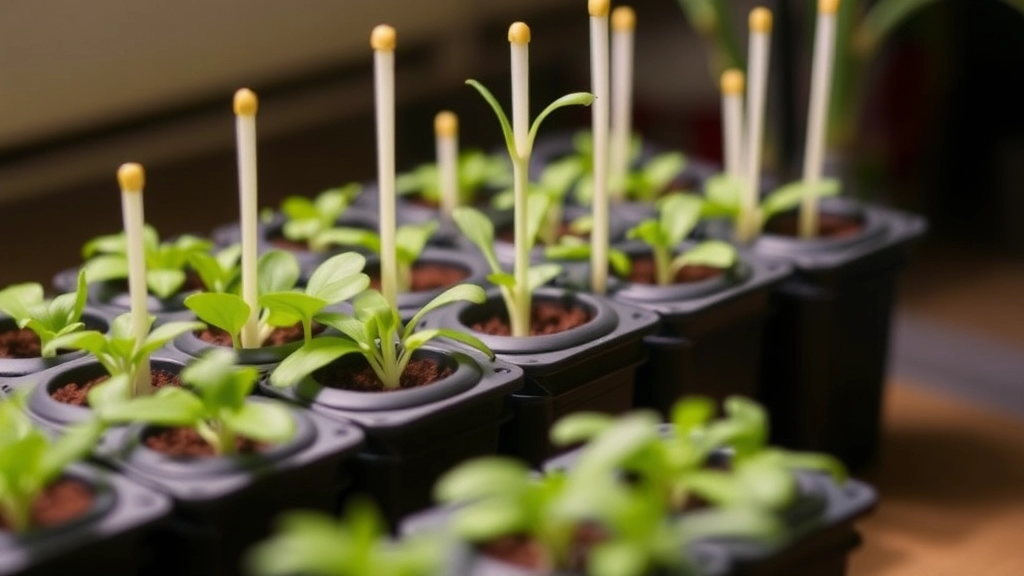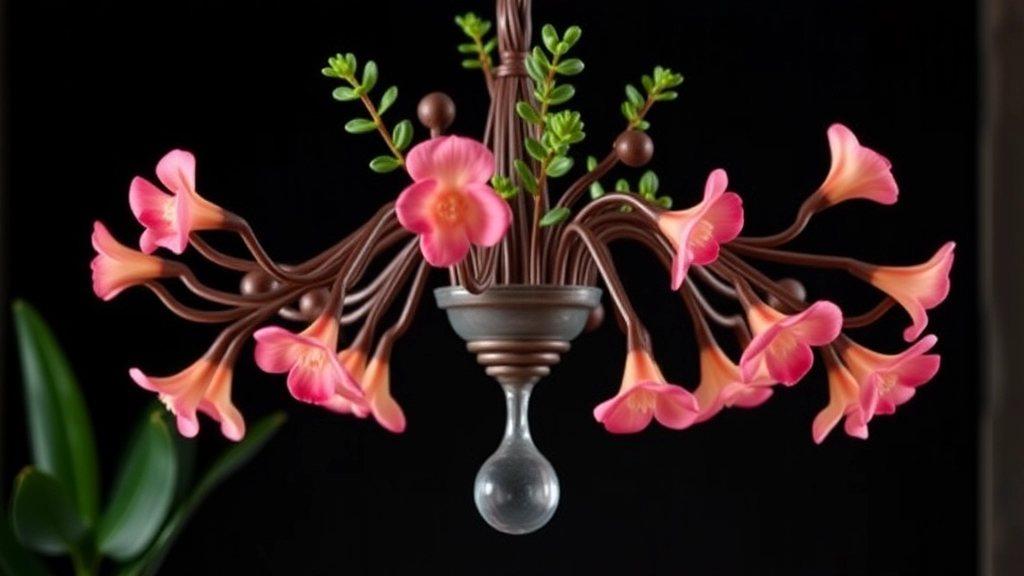Kalanchoe Delagoensis Chandelier Care Guide
Are you fascinated by the unique charm of the Kalanchoe Delagoensis Chandelier? This succulent, also known as the Chandelier Plant or Mother of Millions, is a captivating addition to any garden. In this guide, I’ll share essential care tips to help you grow and maintain this intriguing plant, from understanding its sunlight and watering needs to managing its invasive tendencies.
Let’s dive into the specifics: we’ll cover everything from optimal soil types and potting techniques to effective propagation methods. By the end of this article, you’ll have all the knowledge you need to ensure your Kalanchoe Delagoensis thrives, while also keeping your pets safe from its toxicity. Ready to become a Chandelier Plant expert? Let’s get started!
Essential Care Tips for Kalanchoe Delagoensis
Are you struggling to keep your Kalanchoe Delagoensis thriving?
You’re not alone. Many plant enthusiasts face challenges when caring for this unique succulent.
Here are some essential care tips to ensure your Kalanchoe flourishes:
Light Requirements
- Bright, Indirect Sunlight: Position your Kalanchoe in a spot that receives plenty of bright, indirect sunlight.
- Avoid Direct Sun: Too much direct sunlight can scorch the leaves.
Temperature Preferences
- Warm Temperatures: Kalanchoe Delagoensis thrives in temperatures between 20°C to 30°C.
- Avoid Frost: Protect your plant from cold drafts and frost, as it is sensitive to low temperatures.
Watering Guidelines
- Allow Soil to Dry: Water only when the top inch of soil feels dry.
- Avoid Overwatering: Too much water can lead to root rot.
Soil Needs
- Well-Draining Soil: Use a cactus or succulent mix for optimal drainage.
- Pot with Drainage Holes: Ensure your pot has drainage holes to prevent water accumulation.
Pest Management
- Common Pests: Watch out for mealybugs and aphids.
- Natural Remedies: Use insecticidal soap or neem oil to treat infestations.
Propagation Techniques
- Leaf Cuttings: You can propagate Kalanchoe from leaf cuttings or offsets. For a detailed guide, check out this propagation guide.
- Plantlets: Look for plantlets that form at the leaf edges.
Managing Invasiveness
- Control Growth: Regularly prune to manage size and prevent it from becoming invasive. For more pruning tips, visit this pruning guide.
- Container Growth: Consider potting your Kalanchoe to limit its spread.
Optimal Sunlight and Temperature Conditions

So, you’ve got your Kalanchoe Delagoensis and you’re wondering, “What’s the best way to keep it thriving?”
Let’s dive into the sunlight and temperature needs that make all the difference.
Sunlight Requirements
Kalanchoe Delagoensis loves the sun.
Here’s how to get it just right:
- Bright, Indirect Light: Aim for a spot where it gets plenty of bright, indirect sunlight. A south or west-facing window is perfect.
- Avoid Harsh Rays: Direct sunlight can scorch its leaves, so if you notice any browning, it’s time to move it back a bit.
- Supplemental Light: In winter months, consider using grow lights if natural light is lacking.
Temperature Needs
Temperature is just as crucial.
Kalanchoe Delagoensis thrives in a warm environment:
- Ideal Range: Keep it between 20-25°C (68-77°F) during the day.
- Nighttime Chill: It can handle cooler temperatures at night, but don’t let it drop below 10°C (50°F).
- Avoid Drafts: Keep it away from cold drafts or sudden temperature changes; these can stress your plant.
### Watering Requirements and Best Practices
When it comes to caring for your Kalanchoe Delagoensis, understanding its watering needs is crucial for its health and longevity. Many plant enthusiasts often worry about overwatering or underwatering their succulents.
#### Key Watering Insights
– **Frequency**: Water your Kalanchoe Delagoensis every 2-3 weeks during the growing season (spring and summer). In the dormant months (autumn and winter), reduce watering to once a month.
– **Soil Check**: Always check the soil before watering. Stick your finger about an inch deep; if it feels dry, it’s time to water.
– **Watering Technique**: Use the “soak and dry” method. Water thoroughly until it drains out of the bottom, ensuring the roots get enough moisture, but avoid leaving it sitting in water.
– **Signs of Overwatering**: Yellowing leaves and a mushy stem are indicators of overwatering. Adjust your watering schedule accordingly.
– **Signs of Underwatering**: If the leaves appear shrivelled or wrinkled, it’s a sign that your plant needs more water.
#### Best Practices
– **Use Room Temperature Water**: Cold water can shock the plant. Room temperature water is gentler and helps maintain a stable environment.
– **Consider Humidity**: Kalanchoe prefers drier conditions. High humidity can lead to root rot, so ensure good air circulation around the plant.
– **Seasonal Adjustments**: Be mindful of seasonal changes. As temperatures rise, your plant may require more frequent watering.
For a more comprehensive guide on caring for Kalanchoe plants, check out our [complete care guide for Kalanchoe Blossfeldiana](https://planthq.org/complete-care-guide-for-kalanchoe-blossfeldiana-succulent/). If you’re interested in exploring different varieties, our [guide to Kalanchoe Tomentosa varieties](https://planthq.org/kalanchoe-tomentosa-varieties-care-types-and-propagation/) offers valuable insights.
Soil Types and Potting Needs for Healthy Growth

When it comes to nurturing your Kalanchoe Delagoensis, the right soil and potting conditions are crucial for its thriving.
What Soil Should You Use?
Kalanchoe Delagoensis prefers well-draining soil. Here are some options to consider:
- Cactus Mix: Specifically designed for succulents, this mix allows for excellent drainage.
- Perlite or Pumice: Adding these to your soil can enhance aeration and drainage.
- Regular Potting Soil: If you use standard potting soil, ensure you mix it with sand or perlite to improve drainage.
Potting Considerations
Choosing the right pot can make all the difference. Here’s what to keep in mind:
- Drainage Holes: Always select pots with drainage holes to prevent water accumulation.
- Size Matters: A pot that’s slightly larger than the root ball is ideal. This allows room for growth without retaining excess moisture.
- Material Choice: Terracotta pots are excellent for succulents as they allow the soil to dry out more quickly compared to plastic pots.
Repotting Tips
Over time, your Kalanchoe will outgrow its pot. Here’s how to repot effectively:
- Choose the Right Time: Late spring or early summer is the best time to repot.
- Handle with Care: Gently remove the plant from its old pot, taking care not to damage the roots.
- Fresh Soil: Use fresh soil to fill in around the roots, ensuring it’s well-drained.
When caring for your Kalanchoe Delagoensis, you may encounter various pests that can hinder its growth and health. Understanding these common pests and how to effectively manage them is crucial for maintaining a thriving plant.
**Common Pests**
– **Aphids**
Tiny, green or black insects that suck sap from the plant. Signs include curled leaves and a sticky residue.
– **Mealybugs**
White, cotton-like pests that cluster in leaf joints. They can cause leaf yellowing and stunted growth.
– **Spider Mites**
Tiny spiders that create fine webs on the plant. Look for speckled leaves and webbing.
– **Scale Insects**
Hard, shell-like pests that attach to stems and leaves. They can cause wilting and leaf drop.
**How to Address Pests**
– **Regular Inspection**
Check your plant weekly for any signs of pests. Early detection is key.
– **Natural Remedies**
– **Insecticidal Soap**: Spray on affected areas to suffocate pests.
– **Neem Oil**: A natural pesticide that disrupts pest life cycles.
– **Manual Removal**
For small infestations, wipe pests off with a damp cloth or use a soft brush.
– **Isolation**
If you notice an infestation, isolate the affected plant to prevent the spread to others.
– **Encourage Beneficial Insects**
Ladybugs and lacewings can help control pest populations naturally.
For more detailed tips on keeping your Kalanchoe plants healthy, check out the [complete care guide for Kalanchoe Blossfeldiana succulent](https://planthq.org/complete-care-guide-for-kalanchoe-blossfeldiana-succulent/) and learn about [common names for Kalanchoe Blossfeldiana](https://planthq.org/common-names-for-kalanchoe-blossfeldiana/).
Propagation Techniques: From Plantlets to Cuttings

So, you’re keen to expand your Kalanchoe Delagoensis collection?
You’re in the right place!
Propagation is not only straightforward but also super rewarding.
Let’s dive into the best methods to multiply your beloved plant.
Plantlets
Kalanchoe Delagoensis is known for producing tiny plantlets, often referred to as “pups,” along its leaf edges.
These little guys are a fantastic way to propagate your plant.
Here’s how to do it:
- Wait for the pups: Ensure they’re at least a few inches tall and have developed their own roots.
- Gently remove: Use a clean knife or scissors to cut the pup away from the mother plant.
- Let it dry: Place the plantlet in a dry spot for a day or two to allow the cut to heal.
- Pot it up: Use well-draining soil and plant the pup. Water lightly.
Leaf Cuttings
If you don’t have pups, no worries! Leaf cuttings are another effective method.
Here’s the step-by-step:
- Select a healthy leaf: Look for a robust, undamaged leaf.
- Cut it off: Use a sharp, clean knife to snip the leaf at the base.
- Dry it out: Let the cut leaf sit for a day or two to form a callus.
- Plant it: Place the leaf in well-draining soil, burying the cut end slightly.
- Water sparingly: Keep the soil lightly moist but not soggy.
Tips for Successful Propagation
- Light: Ensure your cuttings get bright, indirect sunlight.
- Humidity: A little extra humidity can help roots develop faster. Consider using a plastic bag over the pot (just don’t forget to ventilate).
- Patience: It can take a few weeks for roots to form, so hang tight!
Managing Invasiveness and Containing Growth
As we explore the essential care tips for Kalanchoe Delagoensis, it’s crucial to address its potential invasiveness. Many plant enthusiasts worry about how quickly this succulent can spread, often overtaking garden spaces if left unchecked.
Understanding Invasiveness
Kalanchoe Delagoensis, commonly known as Mother of Thousands, is notorious for its ability to produce numerous plantlets that can root easily. Here are some effective strategies to manage its growth:
- Regular Pruning:
- Trim back the plant regularly to control its size and prevent it from becoming too dominant in your garden. For more detailed pruning techniques, check out our best tips and techniques for pruning Kalanchoe plants.
- Remove any unwanted plantlets before they take root.
- Container Growth:
- Consider growing Kalanchoe Delagoensis in pots instead of directly in the ground. This makes it easier to manage and prevents it from spreading uncontrollably.
- Barrier Methods:
- Use physical barriers like garden edging to restrict its spread. This can help contain the roots and prevent them from infiltrating other areas of your garden. Learn more about caring for and propagating Kalanchoe Mother of Thousands.
- Soil Management:
- Choose well-draining soil that doesn’t retain excess moisture, as this can encourage overgrowth.
- Amend your soil with sand or perlite to improve drainage.
- Monitor Growth:
- Keep an eye on the plant’s growth patterns and be proactive in addressing any signs of invasiveness.
- If you notice it spreading beyond desired boundaries, take immediate action.
By implementing these strategies, you can enjoy the beauty of Kalanchoe Delagoensis without the worry of it overtaking your garden.
FAQs on Kalanchoe Delagoensis Chandelier
What are the sunlight requirements for Kalanchoe Delagoensis?
Kalanchoe Delagoensis thrives in bright, indirect sunlight. A south or west-facing window is ideal. Avoid direct sunlight as it can scorch the leaves. During winter months, consider using grow lights if natural light is insufficient.
What temperature conditions are optimal for Kalanchoe Delagoensis?
The plant prefers a warm environment with daytime temperatures between 20-25°C (68-77°F). At night, it can tolerate cooler temperatures but should not be exposed to temperatures below 10°C (50°F). Avoid placing it in areas with cold drafts or sudden temperature changes.
What type of soil is best for Kalanchoe Delagoensis?
Kalanchoe Delagoensis requires well-draining soil. A cactus mix is ideal, but you can also use regular potting soil mixed with sand or perlite to improve drainage. Adding perlite or pumice can further enhance aeration and drainage.
What should I consider when choosing a pot for Kalanchoe Delagoensis?
Choose a pot with drainage holes to prevent water accumulation. The pot should be slightly larger than the root ball to allow for growth without retaining excess moisture. Terracotta pots are preferable as they allow the soil to dry out more quickly compared to plastic pots.
When and how should I repot Kalanchoe Delagoensis?
The best time to repot is in late spring or early summer. Gently remove the plant from its old pot, taking care not to damage the roots. Use fresh, well-draining soil to fill in around the roots. Ensure that the new pot has adequate drainage.
How can I propagate Kalanchoe Delagoensis using plantlets?
Wait until the plantlets (pups) are a few inches tall and have developed their own roots. Gently remove them using a clean knife or scissors. Allow the cut to heal by placing the plantlet in a dry spot for a day or two. Then, pot it up in well-draining soil and water lightly.
Can I propagate Kalanchoe Delagoensis using leaf cuttings?
Yes, you can! Select a healthy leaf and use a sharp, clean knife to snip it at the base. Let the cut leaf sit for a day or two to form a callus. Plant the leaf in well-draining soil, burying the cut end slightly. Keep the soil lightly moist but not soggy.
What tips can help ensure successful propagation of Kalanchoe Delagoensis?
Ensure your cuttings get bright, indirect sunlight. A little extra humidity can help roots develop faster; consider using a plastic bag over the pot but remember to ventilate. Be patient as it can take a few weeks for roots to form.
References
-
The Spruce: How to Grow Kalanchoe Delagoensis Indoors
-
Gardening Know How: Caring for Kalanchoe Delagoensis
-
Succulents and Sunshine: Kalanchoe Delagoensis
